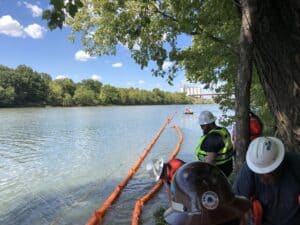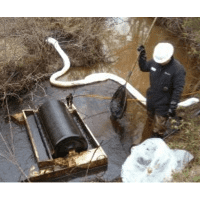Choosing the Right Oil Spill Containment Products
Introduction
Oil spill containment is crucial for the oil and gas industry. This is due to the significant impact it has on economic, environmental, and regulatory issues. Oil spills cause severe damage to marine and terrestrial ecosystems, which affects wildlife, water sources, and communities. Effective containment methods are prominent when mitigating the potential impact of an oil spill. Effective methods also help preserve biodiversity and ensuring the health and safety of the environment.
Economically, oil spills result in financial losses for companies, including costs of cleaning, compensation, legal fines, and reputational damage. Considering implementation of preventive measures for oil spill containment does not only help companies cohere with legal requirements. It can also prove proper corporate responsibility and environmental preservation.
Understanding Oil Spill Containment needs for Oil and Gas
Elevated risk areas in oil and gas operations involve many critical zones where the likelihood of spills is prominent due to operations. Drilling sites, onshore and offshore, are primary areas that involve operation that can result in spill accidents. Transportation routes like pipelines, tanker ships, trucks and railroads are all vulnerable points in transportation. This can result in a spill caused by mechanical failure, collision, and human error during handling processes. Storage facilities such as terminals and tanks create their own risks when considering structural failures and overfilling. Processing plants and storage facilities that have these resources near waterways pose their own risk, potentially causing widespread damage.
A scenario that is quite common takes place on offshore drilling sites where accidents can put large amounts of oil into the ocean. In these locations, containment booms and skimmers can play a prominent role in managing spilled oil. Another scenario involves pipelines where leaks can disperse large amounts of oil within the affected area. Rapid response of spill kits that include absorbent material and containment barriers are critical when preventing widespread damage.
In the oil and gas industry, containment products and prevention services are essential for containing and managing a spill. For example, during offshore drilling operations, a containment boom placed around the drilling platform can prevent oil from spreading into the ocean. Planning ahead saves the environment, marine wildlife and prevents more damage. Additionally, implementing preventive measures, such as placing a containment boom downriver of a storage facility or processing plant can help manage a spill. Doing so adds layers of protection for the environment and surrounding areas.
Types of Oil Spill Containment Products
Containment Boom:
- A boom is a floating barrier used to contain and control the spread of oil in water. They are deployed around an area where oil is present, to contain the oil from spreading. A deployment of a boom will make it easier to collect any spilled oil and prevents oil from reaching land or any area.
A containment boom must include great construction and material quality. Regarding the effectiveness of a boom, high-quality materials like PVC and urethane-coated fabrics are vital for withstanding harsh conditions of an oil spill. Size and deployment mechanisms are important when considering the proper size for certain magnitudes of a spill. Lastly, maintaining durability and weather resistance are crucial when considering strong currents, waves, UV exposure, etc.
Successful use of containment boom: Crude Oil Spill Response (acmeboom.com)
Oil Sorbents:
- These are materials that absorb oil, while simultaneously repelling absorption of water. An oil sorbent comes in many forms, including socks, pillows and pads that are used to clean up a spill quickly from water or land.
- It is important to know what type of sorbent to use and where to use it. Sorbent pads commonly absorb up to 25 times their weight in oil, making them ideal for smaller spills such as leaks and drips. Sorbent rolls, used to reach confined spaces like drains, can absorb up to 15 times their weight. Pillows cover larger areas, and their absorption capacity is like a pad. A sorbent boom, created by stitching multiple sorbents rolls together, allows for high rates of absorption while repelling water. Best practices for using sorbents include placing them properly, inspecting them regularly, and replacing them often.
Skimmers:
- An oil skimmer removes oils from water surfaces. Skimmers separate oil from water, allowing for easier recovery and storage of oil. Typically, responders deploy a skimmer alongside a containment boom to efficiently manage a spill.
- Skimmers help mitigate environmental damage by separating oil from water surfaces. Drum skimmers recover hydrocarbons at different rates, ideally used for inland, marsh, and shallow water spills. Mop skimmers collect and recover oil in a single unit, ideally used for wastewater treatment and hard recovery spills. Disc skimmers recover high ratios of oil/water in harsh conditions in open sea.
Containment Strategy
It is crucial to customize solutions for your specific needs, this involves integrating multiple containment products for a comprehensive plan. From sorbents to a boom, a tailored approach ensures effective containment of oil spills, preventing environmental damage and legal risks. ACME encourages oil and gas companies to assess their containment needs and reach out to ACME for expert guidance and support in implementing a strategy. Because spills happen quickly, do not wait and prepare a containment strategy today to ensure a safe and sustainable future for all.
Conclusion
In conclusion, selecting the right oil spill containment products is crucial for effectively managing and mitigating the environmental impact of oil spills. The right products not only minimize damage to ecosystems and wildlife but also contribute to a faster and cost-efficient cleanup process.
Want to Learn more?
Learn more about our products and check out products that make oil spill cleanup faster and easier Boom Reels – Oil Containment Booms – Acme Environmental (acmeboom.com).
Learn more about how ACME stands out from competition Oil Spill Responders: What Separates ACME Environmental from the Rest? | ACME Environmental (acmeboom.com)
About Us/Our history
Contact Us





